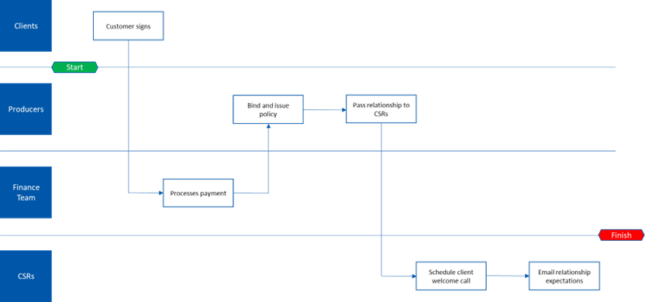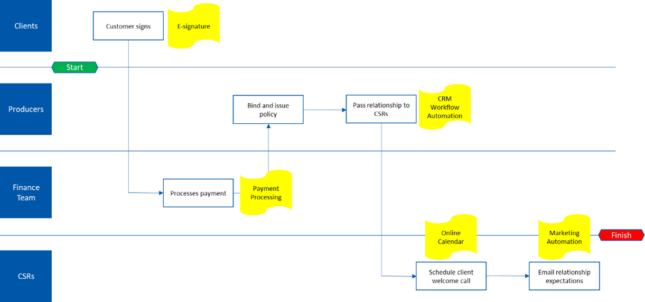Navigating technology: Mapping your agency’s processes
Process mapping is a detailed visual outline of the people, sequence of steps and outcomes associated with completing your agency’s marketing, sales and service initiatives. It is not always considered the first step in developing a technology strategy and driving change management. It is often easier to jump straight into solutions that were mentioned at an insurance conference or promoted during a vendor sales call. In some cases, following the latest trend takes precedent over outlining the current state of your processes and determining the true need(s) that technology may solve.
Although it may be tempting to follow your peers’ purchasing habits and give the next-in-line technology the old college try, let’s determine a way to set your agency up for success through proper planning. We will dive into an easy, step-by-step approach for outlining how you market, sell to and service your clients and identifying room for enhancements using automation.
View the video to walk through the steps and learn more below.
Step 1: Account for the Accountable
Whether you use a visual design software like Visio, the rows and columns of an Excel spreadsheet or simple handwritten notes, the first step is to document key existing processes at the agency. Begin by choosing the agency department you want to focus on (i.e., sales, service, etc.) and a process managed by that department (i.e., selling to the client, onboarding the client, renewing the client, etc.). After solidifying the department and process, you should list everyone which is involved in that task vertically on the left-hand side of the page (see Exhibit 1). For instance, if you are focused on the client onboarding process, you may list rows for the client, producers, finance team and CSRs. As you add each role, separate them with a horizontal line to create “swim lanes”. This delineated white space is where you will account for all the activities managed or influenced by each.
Step 2: Tally the Tasks

Exhibit 1: Stakeholders of the Client Onboarding Process
Now that you have captured the people involved, it is time to associate each stakeholder category with the specific tasks carried out by that stakeholder in the process flow (see Exhibit 2). In the case of onboarding the client, your series of events may read: collect payment, bind and issue policy, pass sales relationship to service, schedule welcome call and send an email thanking and preparing the client for what’s next. Each of these tasks belongs to one or more of the listed stakeholders, and you should note them sequentially from left to right on the page while ensuring the tasks fall into the correct swim lane.
Continuing with our use case, collecting the payment would be a function of the agency’s finance team followed by bind and issuance, which is executed by the producer. As you add each task, you should connect them using a directional arrow to show the sequential progress. Make sure you are as detailed as possible with every task that goes into the process.

Exhibit 2: Current State Client Onboarding Process Map
Once you have completed the identification of tasks by team stakeholders and connected each step in the process to show progression you have effectively accounted for the current state of doing business. Documenting your agency’s approach on paper makes it easy to comprehend and realize potential opportunities for enhancements.
Step 3: Fortify the Future State
In keeping with our client onboarding example, the next step is to imagine a near-term alternative to current state that introduces the possibility of automation to offset manual work. On the same process document, add a flag next to manual tasks that may be reduced or eliminated by automation (see Exhibit 3). For example, collecting payment deserves a flag that calls out the opportunity for online payment processing. Passing the sales relationship to service deserves a flag for setting up an automated trigger in the CRM to notify service that a client has entered the system. Sending a client communication via email deserves a flag for running marketing automation to message customers based on their stage in the onboarding process.

Exhibit 3: Future State Client Onboarding Process Map
Step 4: Vet the Vendors
We have provided tips for vetting technologies that empower agencies to determine the value of a given solution. Using process maps, you are now able to illustrate where proposed platforms fit into the process and deliver the greatest impact. For each action listed, you can also associate monetary and time expenditures in the current model and have prospective vendors communicate possible savings as a result of using their solutions. With a coherent and organized process map you are able to approach procurement discussions objectively.
Change management requires organization and definition. As you modernize practices using technology, the visualization of current and future states of the business allows you to understand possibilities that exist to efficiently grow and retain clients. Consider developing process maps for each stage of the customer lifecycle and use the information to perform incremental improvements, create buy-in with those improvements and incent vendors to rally around your specific agency needs.
Hear Gabe Garcia, Chief Financial Officer of Morris & Garritano Insurance share best practices around selecting and adopting new technology, including insights into mapping processes and training staff.
Citations/Disclaimers
-
The information included in this article and webinars was obtained from sources believed to be reliable, including subject matter experts, to help users address their own risk management and insurance needs. It does not and is not intended to provide legal advice. Nationwide, its affiliates and employees do not guarantee improved results based upon the information contained herein and assume no liability in connection with the information or the provided suggestions. The recommendations provided are general in nature; unique circumstances may not warrant or require implementation of some or all of the suggestions. Nationwide, Nationwide is on your side, and the Nationwide N and Eagle are service marks of Nationwide Mutual Insurance Company. ©2023 Nationwide.

